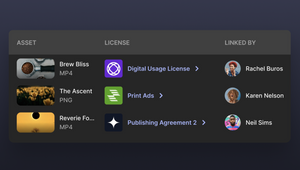
AI: What Is It Good For?

Image credit: Lukas via Unsplash
In the competitive landscape where top-tier brands vie for consumer attention, the challenges of content visibility, control, and the quest to overcome inefficiencies are all too real. Traditional Content Management Systems (CMS) have shown their limitations, often hindering growth due to outdated, non-AI technologies. These systems are overly reliant on human input, struggle to locate approximately 50% of assets, offer only surface-level data insights, and operate within closed, walled garden systems that lack the flexibility for easy integration. Such shortcomings not only fail to meet the needs of modern organisations but also contribute to a broader problem of inefficiency and missed opportunities. Against this backdrop, Artificial Intelligence emerges as a transformative force, poised to redefine content management and engagement. With the introduction of platforms like Medialake, brands have the opportunity to transcend these limitations, leveraging AI for greater efficiency and strategic insight.
Elevating Content Management with Auto Tagging
Amidst the inadequacies of traditional CMS, the value of AI in content management becomes increasingly apparent, especially with features like auto tagging. By automating the categorization and tagging of content, AI addresses critical pain points of these outdated systems by significantly reducing human error and improving the discoverability and reuse of assets. This efficiency is a stark contrast to the human-reliant, often ineffectual methods of legacy CMS, which fail to capture or effectively utilise up to half of a brand's digital assets.
Boosting Creative Productivity
The creative productivity boost offered by AI directly counters the stagnation brought about by conventional CMS platforms. Where traditional systems offer little more than a repository for assets, providing surface-level data at best, AI-driven tools infuse the creative process with dynamic insights and automated processes. This shift not only catalyses creativity but also ensures a level of consistency and relevance that manual systems simply cannot match, highlighting the stark difference in approach and capability between AI-enhanced and traditional content management systems.
Optimising Campaign Planning Through Analytics
Brands are often left navigating in the dark with limited analytics that fail to provide the depth of insight required for informed decision-making. AI changes the game by turning data into a strategic asset, allowing brands to move beyond the closed, walled gardens of legacy systems. The analytics offered by AI-driven platforms enable precise targeting and real-time optimization, meeting the complex needs of today's digital-first organisations.
Building and Protecting Brand Equity
AI's substantial impact to enhancing brand equity is a vital asset. Through advanced data analysis and machine learning, AI tools can identify trends, monitor brand sentiment, and optimise content strategies to strengthen and protect brand reputation. This proactive approach to managing brand equity is something that older, non-AI systems are ill-equipped to handle. By ensuring that content is not only relevant but also positively received, AI-enhanced platforms enable brands to maintain a strong, consistent brand image across all channels, reinforcing the brand's value in the minds of consumers.
Harmonising Brand Consistency with Cultural Agility
Finally, the need for brands to maintain consistency while adapting to cultural shifts highlights the inflexibility and isolation of traditional CMS. In contrast, AI-equipped platforms like Medialake offer the agility and open architecture necessary for brands to dynamically manage and refresh digital assets. This adaptability, crucial for staying relevant in a rapidly evolving market, is something that closed, non-plug-and-play systems of the past simply cannot support.
Conclusion
The addition of AI-driven content data platforms like Medialake represents a pivotal shift for brands, offering a solution for brands to overcome the challenges of inefficiency, poor asset discoverability, and inadequate data insights that have plagued them for too long. In doing so, position themselves for future success in an increasingly digital and dynamic world. AI is not just a tool for growth; it's becoming essential for survival and competitiveness in the modern marketing ecosystem.












